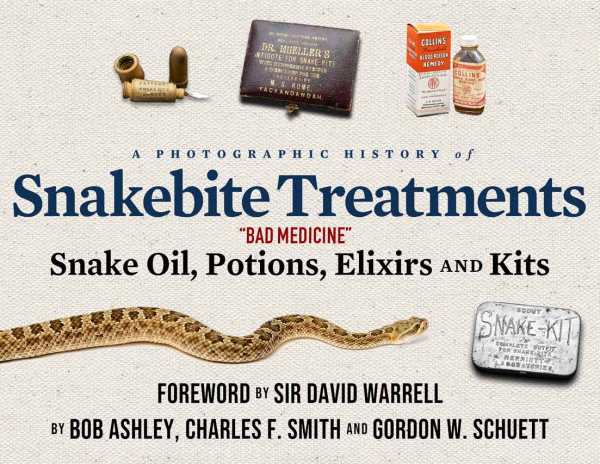
A Photographic History of Snakebite Treatments
"Bad Medicine" Snake Oil, Potions, Elixirs and Kits
An esoteric but informative text, A Photographic History of Snakebite Treatments covers centuries of human responses to the dangers (and potential uses) of snake venom.
Bob Ashley, Charles F. Smith, and Gordon W. Schuett’s A Photographic History of Snakebite Treatments is a jaunty illustrated compendium of snakebite and snake venom–related miscellany.
A complement to the Chiricahua Desert Museum’s collection of snake-related bite kits, oils, and advertisements, this good-natured, esoteric text first marvels over human responses to snakebites over the ages before presenting full-color images of related treasures. Its text is effective at piquing interest even among unversed audiences, replete as it is with parenthetical remarks, puns, and jokes to accompany its rundown of the facts (of a feather-pulling treatment, it remarks “Talk about a fowl practice!”). It argues that the “colorful history of snakebite treatment aptly illustrates both the frailty and ingenuity of human thought”—just note, for example, that some have consumed their own urine in an attempt to counteract venom, even as more scientific minds sought to develop more logical treatments and useful antivenoms.
The first display section is dedicated to snake oils, potions, and elixirs; it mixes advertisements for venom extraction displays, images of snake oil salesmen, and clear depictions of snake oil labels touting its use for ailments ranging from aches to cuts alongside pictures of treatment items for envenomations (bite cures, iodine brushes, and opium to ease the pain). Together, such items reflect the longstanding dichotomy of humanity’s fascination with, and fear of, snakes.
The first section is followed by the longest, dedicated to treatment kits, in which a clip of an insurance advertisement (in essence, for the rental of an treatment kit) is a fascinating peek into former medical approaches to the issue. Herein, longer explanatory captions first appear, inviting audiences into almost a museum visitor’s experience of the items. Where the book’s captions are less descriptive, though, lay interest may waver: the distinctions among the bevy of kits displayed are left in question sans further context.
The third section is dedicated to antivenoms, pointing toward continuing development in medical responses to dangerous bites and crediting minds like nineteenth-century physiology professor Henry Sewall for experiments that led to scientific leaps forward. And the book closes with a section dedicated to written material on the topic. It begins with brief biographies of seventeenth-century researchers whose views reflect outdated misunderstandings of venomous snakes, though, making its material feel somewhat out of order.
In general, the book’s sidebars represent regular opportunities for further learning: there are harrowing introductions to various species of venomous snake and a breakdown of the differences between poisonous and venomous creatures. An explanation of why it’s better to be bitten by a juvenile snake than an older one is shared, while another sidebar discusses the different locations in which a snake’s venom originates. However, some noncorresponding historical information also appears in the midst of the visual presentations to muddling effect, as when an intriguing sidebar regarding the ancient Egyptian Snake Papyrus appears among images of modern snakebite kits—and stretches on for pages. Further, individual sections mix contemporary items with antique ones, moving between eras too freely. While the listed resources after each written section build credibility, such layout choices compromise the book’s linearity and general clarity.
A Photographic History of Snakebite Treatments is an informative, museum-style catalog of antique and contemporary artifacts related to snake venom and envenomation responses.
Reviewed by
Michelle Anne Schingler
Disclosure: This article is not an endorsement, but a review. The publisher of this book provided free copies of the book and paid a small fee to have their book reviewed by a professional reviewer. Foreword Reviews and Clarion Reviews make no guarantee that the publisher will receive a positive review. Foreword Magazine, Inc. is disclosing this in accordance with the Federal Trade Commission’s 16 CFR, Part 255.
